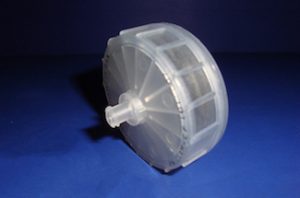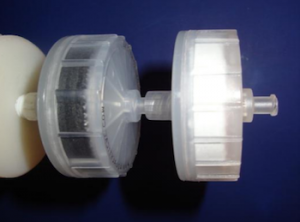C.L.A.M. Laboratory & Application Notes
C.L.A.M Laboratory & Application Notes
SPE Media Types .
Cleaning and Conditioning for Deployment .
Surrogate and Spiking Instructions .
Elution of the C.L.A.M SPE Disk’s
Method Blank and Detection Level Considerations
SPE Media Types
Solid Phase C-18 Extraction Disks

Solid Phase HLB Extraction Disks

Lofted Glass Pre-Filtration Disks

Specialty Media :
Mixed medias and specialized loadings can be arranged with a required minimum order. Some of these include:
- Atlantic™ 8270 One Pass Disk
- Atlantic™ DVB Disk
Cleaning and Conditioning for Deployment
The disks need to be cleaned and conditioned prior to deployment. The steps involve forcing various solvents through the media disk inlet port, using a 50 ml glass syringe taken to waste. The washing and conditioning sequence are as follows:
- Cleaning Step;50 ml of DCM, 1 min. residence, followed by 2 syringe volumes of air.
- Conditioning Step; 50ml of Methanol, 2 min. residence, followed by 1 syringe volume of air.
- Water Conditioning Step; 50 ml of DI water, followed by 1 syringe volume of air.
- If spiked standards are to be added continue to the spiking instruction section, if not, the disks are capped with the Luer Lock plugs provided, and placed in the metal foil pouch for shipment to the field.

Retrieving disk from metalized pouch
Surrogate and Spiking Instructions
The quality assurance plan or method will often determine if any and what type of spiking standards are to be added for field deployment, or for laboratory elution after deployment, or for both. 
- The field or elution spiking solutions should be made up in a water soluble solvent such as methanol or acetone at a concentration that would use no more the 100 ul of solution per spiking addition.
- The disk is spiked directly by inserting the spiking syringe needle into the inlet and spiking the pre-filtration media.
- The disk is then rinsed with 50 ml of DI water followed by 1 syringe volume of air, to set the spike onto the media.
- The disk can then be capped, and is ready for field deployment.
- If method blanks, trip blanks or laboratory spike/ spike duplicates or matrix field spikes are to be used for method compliance, they will be spiked using the same procedure.
- If the disk has been deployed, and elution standards such as; recovery surrogates, matrix spikes, internal standards, or isotopic dilution standards need to be added, the same procedure is performed prior to elution of the analytes.
Elution of the C.l.A.M. SPE Disk’s
It is essential to remove the water within the SPE disk before the solvent elution. The SPE disk with its enhanced filtration media will retain 5ml or more of water even after vacuum drying. We have found the following method to be simple and effective in removing the water, allowing full media contact to the elution solvent. The procedure simply displaces the water in the disk with methanol, then elutes the disk with DCM. All the elutant is collected and partitioned with DI water in a small separatory funnel. The funnel is lightly shaken allowed to settle removing the methanol from the DCM, which is then collected, concentrated and then analyzed; (see steps below). 
- With a 50 ml glass syringe slowly elute 50 ml methanol through the disk into a 250- ml Separatory funnel.
- The next step is to slowly pass 50 ml of DCM using the same syringe through the disk into the receiving separatory funnel, followed by an additional 25ml of DCM.
- Add 100 ml DI water adjusted to pH 2 to the separatory funnel, swirl and shake lightly for 30 seconds, this step just removes the methanol from the DCM and partitions it into the water phase.

Laboratory Operations - Allow to settle, then draw off the bottom DCM phase into a concentration vessel.
- The steps are repeated by eluting an additional 50 ml of DCM through the extraction disk, and into the separatory funnel.
- The total of the DCM extract can be concentrated by KD, nitrogen blow down, or by any other solvent reduction method to produce a final extract volume.
- The volume of extracted solvent can be exchanged to fit the instrument and analysis type such as; hexane for ECD analysis, or DCM for GC/MS or GC/MS/MS analysis. The extract can then be dried, cleaned up and concentrated to the desired volume required for detection requirements.
C.L.A.M Instrument Data Calculations

𝐼𝑛𝑠𝑡𝑟𝑢𝑚𝑒𝑛𝑡 𝑅𝑒𝑠𝑢𝑙𝑡 (𝑛𝑔/𝑚𝑙) × Solvent 𝑉𝑜𝑙. (𝑚𝑙)=Total weight present in (𝑛𝑔)
Total Weight (𝑛𝑔) / 𝑇𝑜𝑡𝑎𝑙 𝑉𝑜𝑙𝑢Water 𝐸𝑥𝑡𝑟𝑎𝑐𝑡𝑒𝑑 (𝐿) =𝑊𝑎𝑡𝑒𝑟 𝐶𝑜𝑛𝑐.(𝑛𝑔/𝐿)
- Example:
Instrument raw data from ICAL curve = 4.036 ng/ml
Solvent Extract Vol.=2.0 ml
Total Volume Water Extracted=80 L
- Calculation:
4.036 ng/ml x 2.0 ml = 8.1 ng
8.1 ng / 80L= Water concentration of 0.101 ng/l
Method Blank and Detection Level Considerations
The EPA defines the MDL as the “minimum concentration of a substance that can be measured and reported with 99% confidence that the analyte concentration is greater than zero. Laboratories determine method detection limits by running 7 replicated analysis, at the low point of their initial calibration, using standard sample deviation. These analyses are matrix, analyst, instrument and method specific. The CLAM disks are treated like any other laboratory SPE disk wafer or cartridge, they are the same SPE media disks used by laboratories that we place into a utilitarian encasements.
A one liter volume is usually used to determine the MDL for trace organics in water analysis methods. Once these values are determined they are inserted into the laboratory calculation formula spread sheets or LIMS which will usually apply factors to calculate the sample concentrations which are based on sample volume used, and extract volume concentrations. The MDL and associated field and method blanks will be scaled accordingly for each sample, applying acceptance criteria and determining PQL and RL’s and data qualifiers.
